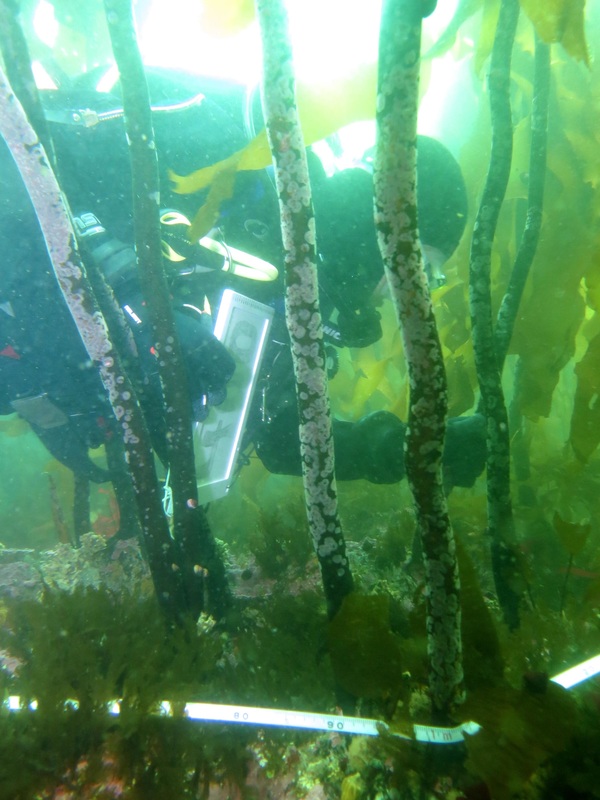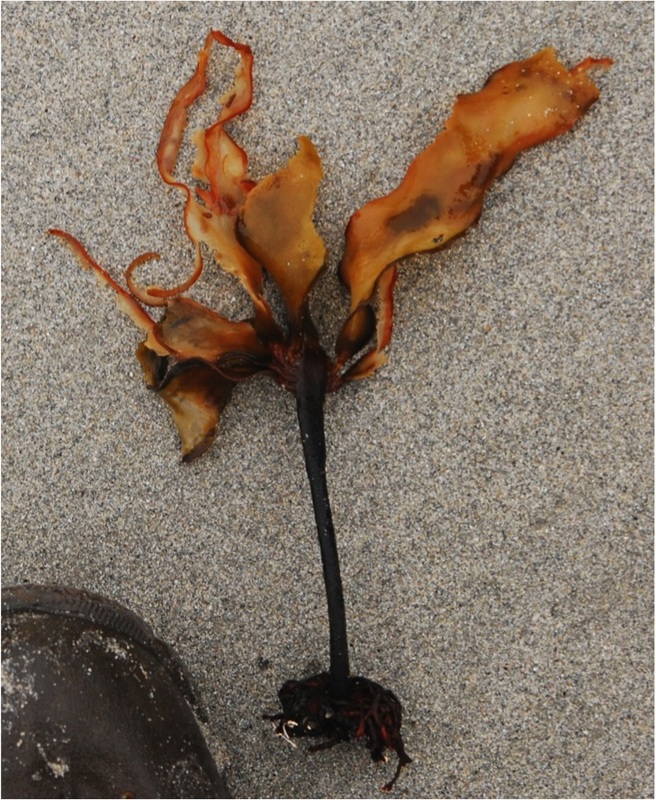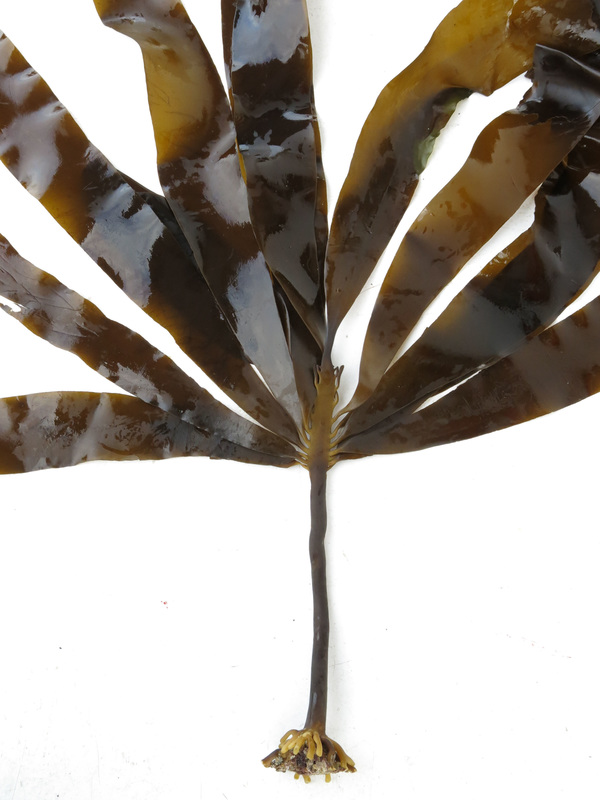Woody-stemmed kelp, stalked kelp, walking kelp • Pterygophora californica
{Pterygophora = bearing wings}
Identification
As per its name, woody-stemmed kelp has a stiff, solid, woody stipe that reaches 1.5 m long. At the end of the stipe is a small terminal blade, with longer blades extending from either side. The terminal blade is smooth and has a faint midrib; the side blades are sporophylls and do not have midribs. The whole structure is supported by a large hapteroid (branching) holdfast. The holdfast is somewhat conical in shape, and can be up to 15 cm across. Altogether this kelp can be over 2 m tall.
Habitat & Range
Woody-stemmed kelp grows on subtidal rock (to 20 m) and cobble of exposed coasts. It prefers areas that are extremely exposed, and experience heavy wave action. Its range extends from Kodiak Island in Alaska to Baja California, Mexico.
Similar Species
This is the only kelp with a stiff, woody stipe, and can easily be mistaken for driftwood when washed up on the high tide line.
Intriguing Info
Despite its name and its resemblance to driftwood, woody-stemmed kelp does not burn effectively in campfires. This perennial kelp is long-lived, earning it the common name (one of many) of old growth kelp. The stipe has annual rings like a tree trunk, and so can be aged; individuals may live for up to 25 years.
As per its name, woody-stemmed kelp has a stiff, solid, woody stipe that reaches 1.5 m long. At the end of the stipe is a small terminal blade, with longer blades extending from either side. The terminal blade is smooth and has a faint midrib; the side blades are sporophylls and do not have midribs. The whole structure is supported by a large hapteroid (branching) holdfast. The holdfast is somewhat conical in shape, and can be up to 15 cm across. Altogether this kelp can be over 2 m tall.
Habitat & Range
Woody-stemmed kelp grows on subtidal rock (to 20 m) and cobble of exposed coasts. It prefers areas that are extremely exposed, and experience heavy wave action. Its range extends from Kodiak Island in Alaska to Baja California, Mexico.
Similar Species
This is the only kelp with a stiff, woody stipe, and can easily be mistaken for driftwood when washed up on the high tide line.
Intriguing Info
Despite its name and its resemblance to driftwood, woody-stemmed kelp does not burn effectively in campfires. This perennial kelp is long-lived, earning it the common name (one of many) of old growth kelp. The stipe has annual rings like a tree trunk, and so can be aged; individuals may live for up to 25 years.
References
Druehl, L. (2000). Pacific Seaweeds: a guide to common seaweeds of the West Coast. Madeira Park, BC: Harbour Publishing. Pp. 84-85.
Lamb, A., and Hanby, B. (2005). Marine Life of the Pacific Northwest [electronic resource]. Madeira Park, BC: Harbour Publishing.
Lindberg, M. and Lindstrom, S. (2010). Pterygophora californica. Seaweeds of Alaska. Accessed 29/07/2014.
O'Clair, R. and Lindstrom, S. Pterygophora californica Ruprecht. In Klinkenberg, Brian. (Ed.). E-Flora BC: Electronic Atlas of the Plants of British Columbia. Lab for Advanced Spatial Analysis, Department of Geography, University of British Columbia, Vancouver. Accessed 29/07/2014.
Authors and editors of page
Joel White, Kelly Fretwell, and Brian Starzomski (2014).
Druehl, L. (2000). Pacific Seaweeds: a guide to common seaweeds of the West Coast. Madeira Park, BC: Harbour Publishing. Pp. 84-85.
Lamb, A., and Hanby, B. (2005). Marine Life of the Pacific Northwest [electronic resource]. Madeira Park, BC: Harbour Publishing.
Lindberg, M. and Lindstrom, S. (2010). Pterygophora californica. Seaweeds of Alaska. Accessed 29/07/2014.
O'Clair, R. and Lindstrom, S. Pterygophora californica Ruprecht. In Klinkenberg, Brian. (Ed.). E-Flora BC: Electronic Atlas of the Plants of British Columbia. Lab for Advanced Spatial Analysis, Department of Geography, University of British Columbia, Vancouver. Accessed 29/07/2014.
Authors and editors of page
Joel White, Kelly Fretwell, and Brian Starzomski (2014).






